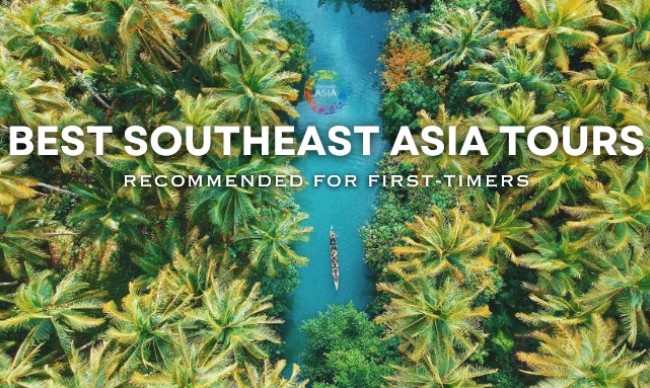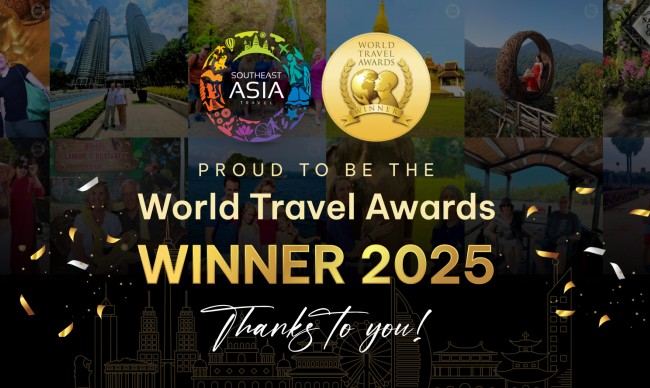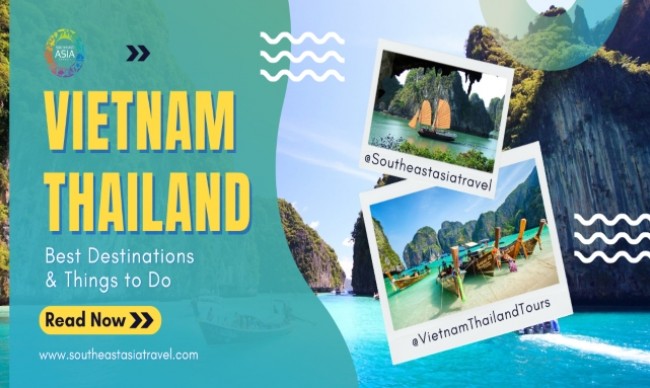Southeast Asia is a haven for travelers seeking thrill and adventure. With its stunning natural landscapes, diverse cultures, and affordable travel costs, this region offers countless opportunities for exploration. From dense jungles and towering mountains to pristine beaches and vibrant underwater worlds, here are some of the best destinations in Southeast Asia for adrenaline junkies.

1. Chiang Mai, Thailand
Nestled in northern Thailand, Chiang Mai is a hub for adventure in the region's lush mountains. Trekking through the dense jungle, visiting remote hill tribe villages, and zip-lining through the forest canopy are popular activities. For animal lovers, ethical elephant sanctuaries offer the chance to interact with these majestic creatures in their natural habitat. The surrounding areas also provide opportunities for white-water rafting and mountain biking.

Best time to visit: November to February. The cooler season is ideal for trekking and outdoor adventures, with lush greenery from recent rains.
How to get there: Chiang Mai is easily accessible by air, with Chiang Mai International Airport (CNX) serving numerous domestic and international flights daily, including connections from Bangkok, Singapore, Kuala Lumpur, and more. Alternatively, private car rentals or rideshares are available for those who prefer a road trip experience.
Useful Tips: If you're trekking, consider hiring a local guide for a safer and more enriching experience.

2. Bali, Indonesia
Bali is synonymous with paradise, but beyond its tranquil beaches lies a world of adventure. Hike up Mount Batur to witness a breathtaking sunrise, cycle through the lush rice terraces of Ubud, or explore the dramatic cliffs and waterfalls scattered across the island. Water sports enthusiasts can enjoy surfing at Uluwatu or scuba diving in Nusa Penida, where manta rays and vibrant marine life abound. For a cultural twist, venture into the sacred Monkey Forest or visit ancient temples like Besakih and Tanah Lot perched on dramatic coastlines.

Best time to visit: May to October. The dry season offers sunny skies for hiking, surfing, and exploring Bali’s natural wonders.
How to get there: Bali is most commonly accessed via Ngurah Rai International Airport (DPS), also known as Denpasar Airport. The airport is well connected to major international hubs such as Singapore, Kuala Lumpur, Bangkok, and Sydney, as well as domestic flights from Jakarta and other Indonesian cities. For travelers coming from neighboring islands like Java or Lombok, ferries and speedboats provide convenient sea routes to Bali’s ports, including Gilimanuk and Padang Bai.

3. Mount Kinabalu, Malaysia
Mount Kinabalu, located in Sabah on Borneo Island, is the promised land for trekkers and nature enthusiasts. Standing at 4,095 meters, this UNESCO World Heritage Site is the tallest peak in Malaysia. The climb to its summit, known as "Low's Peak," offers stunning views of the sunrise and challenges even seasoned hikers. For those looking for an extra adrenaline rush, the Via Ferrata, the world’s highest iron rope climb, is a must-try.
Best time to visit: March to May. These months are dry, offering clear skies and the best conditions for trekking to the summit.

How to get there: Mount Kinabalu is accessible via Kota Kinabalu International Airport (BKI), which receives domestic and international flights from major cities like Kuala Lumpur, Singapore, and Manila. From Kota Kinabalu, travelers can reach Kinabalu Park, the starting point for the climb, by car or bus.
Useful Tips: For convenience, many visitors opt for organized tours that include transportation to the park. Advanced booking is essential, as permits to climb Mount Kinabalu are limited and in high demand.

4. Sapa, Vietnam
Nestled in Vietnam’s northern mountains, Sapa’s terraced rice fields and misty valleys make it an excellent destination for trekking enthusiasts. Guided hikes take travelers through picturesque landscapes, visiting local Hmong and Dao communities along the way. For a greater challenge, conquer Mount Fansipan, the highest peak in Indochina, known as the “Roof of Indochina.” The reward is breathtaking views from the summit.

Best time to visit: March to May and September to November. Spring and autumn offer comfortable trekking conditions and stunning views of the terraced rice fields.
How to get there: Sapa is most commonly reached from Hanoi, about 320 kilometers away. The most popular option is a direct bus from Hanoi, which takes approximately 5–6 hours. Alternatively, travelers can take an overnight train to Lao Cai, the nearest station, followed by a 1-hour bus or taxi ride to Sapa. For a more comfortable journey, private car services are also available.

5. Komodo National Park, Indonesia
Home to the legendary Komodo dragon, Komodo National Park is an adventure lover's dream in Indonesia. The rugged terrain of the islands invites hikers to climb to panoramic viewpoints, while the underwater world is equally captivating. Dive or snorkel in the vibrant coral reefs, where manta rays, sea turtles, and an array of marine life thrive. The Pink Beach, with its unique rose-colored sands, adds to the park’s allure.
Best time to visit: April to June and September to November. These shoulder seasons offer the best diving conditions, calm seas for island-hopping, and fewer crowds.

How to get there: Komodo National Park is best accessed via the town of Labuan Bajo on Flores Island. Travelers can fly directly to Komodo Airport (LBJ) in Labuan Bajo from major Indonesian cities such as Bali (Denpasar) or Jakarta. From Labuan Bajo, the park’s islands, including Komodo and Rinca, are reachable by boat, with options ranging from day trips to multi-day liveaboard tours.
Useful Tips: Always follow the guidance of park rangers for safety, as the dragons are wild animals.

6. Luang Prabang, Laos
Luang Prabang combines cultural exploration with outdoor adventure. The Mekong River is perfect for kayaking and river cruises, while nearby Kuang Si Falls offers swimming in turquoise pools and hiking through dense forest trails. For an elevated thrill, travelers can take part in multi-day trekking excursions to explore rural villages, caves, and ancient temples.
Best time to visit: November to February. Cool and dry weather makes outdoor activities like hiking and kayaking more enjoyable.

How to get there: Luang Prabang is easily reachable by air, road, or river. Luang Prabang International Airport (LPQ) offers direct flights from big cities like Hanoi, Bangkok, and Chiang Mai. For those traveling by road, buses and trains connect Luang Prabang to other Laos' cities such as Vientiane and Vang Vieng. Alternatively, adventurous travelers can take a slow boat or speedboat along the Mekong River from Huay Xai near the Thai border.

7. Palawan, Philippines
Palawan, often called the "last ecological frontier of the Philippines," boasts unparalleled beauty and adventure options. The island’s El Nido and Coron regions are renowned for dramatic limestone cliffs, hidden lagoons, and crystal-clear waters. Travelers can enjoy snorkeling, scuba diving in World War II shipwrecks, and island-hopping tours to discover unspoiled beaches. Inland, the Puerto Princesa Underground River is a natural wonder waiting to be explored.
Best time to visit: November to May. The dry season ensures calm seas for island-hopping and clear skies for exploring the Underground River.

How to get there: Palawan is well accessed by air. Travelers can fly directly to Puerto Princesa International Airport (PPS) from major cities like Manila and Cebu. From Puerto Princesa, visitors can travel by van, bus, or private car to popular destinations like El Nido (5–6 hours) or Coron (via ferry or flight). Coron is also accessible by direct flights to Busuanga Airport (USU).

8. Bagan, Myanmar
Bagan is famous for its ancient temples, but it also offers unique adventures for intrepid travelers. Exploring the vast plain of over 2,000 temples by bicycle or electric scooter provides an exhilarating mix of history and exploration. For an unforgettable experience in Myanmar, take a hot air balloon ride at sunrise, floating above the ancient city’s golden spires and lush greenery.
Best time to visit: November to February. The cooler months are perfect for exploring temples and enjoying hot air balloon rides over the plains.

How to get there: Bagan is accessible by air, road, or river. The quickest way is to fly to Nyaung U Airport (NYU), with domestic flights available from Yangon and Mandalay. By road, buses connect Bagan to major cities. For a more scenic option, travelers can take a leisurely boat ride along the Irrawaddy River from Mandalay to Bagan.
Useful Tips: For a truly magical experience, get up early or head out in the late afternoon to catch the temples bathed in golden light.

9. Taman Negara, Malaysia
Taman Negara, Malaysia’s oldest national park, is bliss for jungle adventures. Spanning over 4,000 square kilometers, the park offers activities like canopy walks, jungle trekking, and river safaris. Spotting wildlife such as monkeys, hornbills, and even tigers (if you're lucky) adds to the excitement. Night safaris provide a unique opportunity to experience the rainforest's nocturnal wonders.
Best time to visit: March to October. This is the dry season, making jungle treks, river safaris, and canopy walks more enjoyable.

How to get there: Taman Negara is reached by road and river from Kuala Lumpur. The most common route is to drive or take a bus to Kuala Tembeling Jetty, about 3–4 hours away. Then, board a scenic 2–3 hour boat ride along the Tembeling River to Kuala Tahan, the park’s gateway. Alternatively, direct buses or private transfers to Kuala Tahan are available for those who prefer to skip the boat journey.
Useful Tips: Taman Negara is vast, and hiring a local guide can enhance your experience.

10. Quang Binh, Vietnam
Quang Binh province, located in central Vietnam, is an adventurer's dream come true thanks to its extraordinary cave systems and lush landscapes. The world-renowned Son Doong Cave, the largest cave on Earth, offers a multi-day expedition into a surreal underground world with massive chambers and unique ecosystems. Phong Nha-Ke Bang National Park, a UNESCO World Heritage Site, is home to other stunning caves like Paradise Cave and Dark Cave, where you can zip-line, kayak, and swim through crystal-clear rivers. The surrounding jungle and rivers also provide excellent trekking and outdoor exploration chances.
Best time to visit: February to August. These months have dry weather, ideal for exploring caves and trekking in Phong Nha-Ke Bang National Park.

How to get there: Quang Binh is easy to get to by air, train, or bus. Dong Hoi Airport (VDH), the main gateway to the province, receives direct flights from Hanoi, Ho Chi Minh City, and other major cities. For a scenic alternative, travelers can take a train on the North-South Railway, which stops at Dong Hoi Station. Long-distance buses also connect Quang Binh to nearby cities like Hue and Da Nang.
Useful Tips: If you're planning to explore the incredible caves like Son Doong, book cave tours with Oxalis Adventure in advance, as they often require permits and guides.

General Tips for Adventure Travel in Southeast Asia
- Packing: Bring lightweight, moisture-wicking clothing, sturdy hiking shoes, and waterproof gear for sudden rain.
- Safety: Always choose reputable guides and operators for activities like trekking, diving, and caving.
- Cultural Sensitivity: Respect local customs and dress codes, especially in rural or sacred areas.
- Health Precautions: Stay hydrated, use insect repellent, and ensure your vaccinations are up to date.
- Travel Insurance: Essential for covering adventure activities and medical emergencies.

Southeast Asia is a treasure trove of adventure, offering experiences that cater to travelers of all ages. Whether it’s scaling mountains, diving into the ocean depths, or exploring ancient ruins, the region promises unforgettable thrills and moments of awe. Pack your bags, and let your adventure in Southeast Asia begin!
































